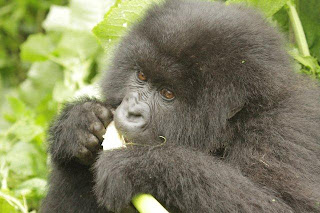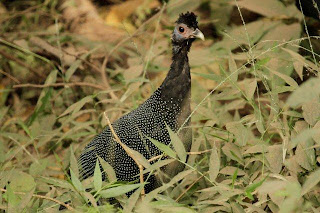Rwanda is aptly known as the ‘Pays des Milles Collines’ (Land of a
Thousand Hills). Our group split up into 4 groups to explore some of these hills,
all in search of the mountain gorilla.
This was my second visit to the gorillas. In 2009, I visited the
Susa group, the one that Dian Fossey studied. And this time, I was fortunate enough to visit them again.
Josh, Sonny, Dom, Ron, and I were in the same group, accompanied
by three other individual travellers: Ingrid, a Kiwi; Alex from Bris-Vegas; and
Hamish from the UK. Our guides were Patrick and Roger, and they gave us a
briefing on the park and the Susa group.
The park
spans Rwanda, Uganda and the DRC. In Rwanda, there were 18 gorilla groups until
recently when one group came over into the Rwandan side from Uganda, making 19 in
total.
The Susa group is the largest with 35 members. Only the research
group is larger with 44 but members of the public cannot visit them. Kurira is
the number one Silverback and the group contains twins which is a rarity. The last
time I saw them, the twins would have been six. Now they are nine, and one of
them has a 3 month old baby.
We were told you can differentiate gorillas by their nose prints
and were taught how to make gorilla noises like our group did last time, a kind
of double grunt to tell them you are not a threat.
Our group of 8 set out in two 4x4s for a ridiculously bumpy one
hour drive to the Susa group trek starting point. I was crammed in the back in
one of two separate seats elevated so high that my head hit the ceiling with
every bump. It wasn’t at all a surprise when we got a flat tyre as the road was
so rough but it was a surprise when our driver attempted to re-inflate the tyre
instead of changing it. As it turns out, the tyre had to be changed so we used
the one 4x4 to make two trips to the starting point.
The beginning of the trek through farmland was very familiar as
I’d done it so recently. Villagers were all calling out ‘Mzungu!’ and waving
excitedly at us. The walk was fairly steep and the pace had initially been set
quite quickly. I was breathing heavily but managed to keep up. Josh, however,
didn’t fare so well, and threw up just before we reached Buffalo Wall, the
entrance to the park. Bear in mind we haven’t done much exercise lately and
Josh also had two Doxy pills that morning by accident which could’ve had
something to do with it.
During our quick rest in front of the wall, I asked Patrick what
his favourite experience had been with the gorillas and he mentioned two: one
where the second silverback was at the back of the group and got ‘too curious’;
and another where the babies were drunk on bamboo and jumped all over them!
Roger then told us to be prepared for a 45 minute to one hour hike
but just 15 minutes into it, we found the trackers waiting for us. Roger was very
surprised to see them so soon – we were just lucky (or unlucky I guess if one
wanted a long hike!) The path was definitely suited for short people – despite
bending over as low as I could, I kept getting caught in the vines and bamboo.
When we reached the trackers, we left our bags and walking sticks
behind, taking only our cameras with us. As soon as we walked through the thick
bushes, we could see their black fur.
The Susa group were resting and the
babies were playing around. One adolescent was doing cartwheels either to get
around or to just entertain himself.
I asked to see the newborn twins and Roger led me over to see
them. It was tricky walking around them as the leaf litter was extremely
slippery. As I was looking at the newborns, one gorilla had an altercation with
another and another two got involved. The result: one gorilla started charging
in my direction and one charged Ron, Sonny and Hamish. I was petrified. I was
so petrified I didn’t know what to do – not that you can really do anything
aside from standing your ground – the last thing I felt like doing! The thought
I should be filming it did cross my mind but I was unable to operate my camera
at that point in time – my body wasn’t responding aside from shaking with fear.
Ron was the closest to them and had to end up moving otherwise he would’ve been
bowled over! Nonetheless, all of our hearts were racing after that incident.
After settling down and actually being able to take some photos,
the gorillas walked off in search of food. ‘Play time’ (if you could call it that!)
was over. We followed them into thicker bush and watched them eat.
One silverback cheekily started mating with a female – unless
they’re the No.1 silverback, they’re not allowed to mate with the females and
will often be beaten by the No.1 if they’re caught in the act. He looked very
guilty for a while (I thought) but then carried on as normal, eating and pretending
nothing had happened!
We saw the gorillas walk off in a chain again with babies on their
backs while one was swinging from a tree. Another two, one with a baby on its
back, walked right in front of us – they must’ve been about 1-2 metres away. It
was incredible.
They really are beautiful creatures but they’re still quite
scary!
We were told when we had 12 minutes left and it felt like we’d only been
there for moments. Before we knew it our hour was up so we sadly had to leave
them but having seen them play, charge, eat and mate was a pretty mind-blowing
experience for just one hour!













































































